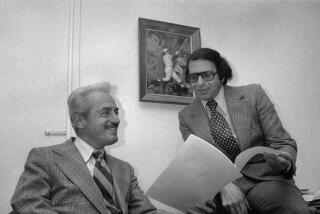Baseball Fire Sale Goes Back to Mack
Connie Mack would be right at home in today’s baseball.
Connie Mack was Cornelius Alexander McGillicuddy, the prototypical baseball manager against whom all others are measured.
He won more games--3,776--than any other manager. He also lost more--4,025.
He managed for 53 years. He was famous for standing in a corner of a dugout in celluloid collar, conservative tie and sleeve garters, waving a rolled-up program at his athletes to signal them where to play the hitters or when to hit the pitches. He won nine pennants and five World Series. He was famous for building championship teams.
He was equally famous for tearing them down. He treated ball teams the way a farmer treated crops. He planted them, cultivated them, trained them, nurtured them, used them--then went to market and sold them to the highest bidder. He thought ballplayers were like rutabagas. Cash crops.
Almost immediately after every pennant run, Connie would package his star players and shop them like a guy selling gold bricks. He took the position that he could replace them. There were always more where these came from.
He used to justify his excesses by claiming that Philadelphians got cloyed with winning. Maybe so. But they sure got cloyed with losing. When he stripped his 1914 team, attendance dipped from earlier highs of 674,915 to a paltry 146,223.
Meanwhile, of course, the Mack family pocketed the money from the dispersal. He didn’t trade the players. He sold them. He was not only reducing his payroll, he was building his bank account.
In 1914, a great Mack team with Home Run Baker and a so-called “$100,000 Infield” was put on the market after a pennant year. And the infield proved prophetically named, over two years, when Mack sold Hall of Fame second baseman Eddie Collins for $50,000, third sacker Baker for $37,500 and shortstop Jack Barry for $8,000.
The 1914 pennant winners promptly finished last in 1915. Mack set about painstakingly to plant another field of dreams.
You have heard of the 1927 Yankees as baseball’s best? Well, maybe. But the 1929 Philadelphia Athletics might have been every bit as good. The ’27 Yankees had Ruth and Gehrig. But the ’29 A’s had Foxx and Simmons.
How good were the ’29 A’s? Well, a story of the time they were playing in Yankee Stadium may suffice. They were rallying in a late inning against the Yankees when the Yankee manager got on the phone to the bullpen, where his ace reliever, Henry Johnson, was warming up. Johnson had just purchased a hot dog when he picked up the phone. “Johnson,” barked the manager, “get in there and relieve Pipgras.” Johnson was suspicious. “Who’s coming up?” he wanted to know. “Cochrane, Simmons and Foxx,” he was told. Johnson hung up the phone, turned to his fellow relievers. “Don’t touch that hot dog,” he growled. “I’ll be right back.”
Mack sold Jimmie Foxx, who had only hit 58 home runs one year, to the Red Sox for $150,000 and two players. He sold Al Simmons to the White Sox (with Jimmy Dykes and Mule Haas) for $100,000. In the pit of the Depression, those were big bucks.
He sold Lefty Grove, who had posted a record of 31-4 one year and had won 108 games in one four-year stretch to the Red Sox for $125,000.
Mack thought he could build another winner. He had the formula, he felt.
He didn’t. He finished last 10 times in his last 15 years. Philadelphia fans got bored with that, all right. The franchise hit the road, first to Kansas City, then Oakland.
The teams tossing players out of the sled nowadays could learn from Connie. They are actually less motivated by the money they can get than the money they can save. They are unloading payrolls, not athletes.
It’s ironic that baseball ownership should get from a strike precisely what caused the strike in the first place--a built-in salary cap. The salary cap is being implemented the way it should have been in the first place. By individual owners acting individually.
The Montreal Expos have trimmed 1) their No. 1 starting pitcher, Ken Hill; 2) their No. 1 reliever, John Wetteland; 3) their All-Star outfielder, Larry Walker; and 4) their fleet outfielder and base-stealing leader, Marquis Grissom. That’s an entire team.
Connie Mack would have understood perfectly but, unlike Connie, they didn’t get money in the trade. They just cut the overhead. Walker, alone, was getting $4,025,000 last year.
The Kansas City Royals unloaded their Cy Young Award winner, David Cone. He would have cost them $5 million this year. They let the profitable Toronto Blue Jays worry about it.
One result of the strike provides a dubious trend for the union. Salaries are plummeting. The practice fields of Florida are awash with free agents. They are falling all over themselves to sign with the nearest bidder. A future Hall of Famer like Andre Dawson, who played for $4,425,000 last year, is signed for $500,000 this year. Baltimore’s Mike Devereaux goes from the Orioles and $3,375,000 to the White Sox and $800,000. Starting pitcher Bud Black, who got $3,250,000 from the Giants last year, will get $350,000 from the Indians this year. Starting pitcher Dave Stewart goes from $4,250,000 to $1,000,000. And so on.
Has sanity been restored? Well, not exactly. Just as the owners had predicted, the small-market have-not franchises have been forced to unload star players to the big-market haves. The Montreal Expos already had the lowest payroll ($18.5 million) in the game. Now, they must lower it further. But the cash-swollen Colorado Rockies, who outdrew all of baseball last year, were able to offer Montreal’s Walker a $1.5-million raise and a four-year deal worth $22 million.
The good news is high-priced performers do not always deliver high-end performances. Connie Mack’s off-loads were a case in point. Grove went from 24-8 to 8-8 in Boston; Simmons, who hit .390 and .392 for Mack, tailed off in Chicago; even Baker, who led the league in homers four times for the Athletics, never did it again with the Yankees.
The irony of the story is the union, which struck against a salary cap, ended up forcing one on the owners. And, in spite of the fact the federal courts awarded the union a victory of sorts, the payoff is that some of the union members ended up taking $2-million-a-year pay cuts.
Mack never needed a strike to show him how to play that game. All you needed to know was how to add. And subtract. Connie brought in replacement players every five years or so. And he had his own method of revenue-sharing.
More to Read
Go beyond the scoreboard
Get the latest on L.A.'s teams in the daily Sports Report newsletter.
You may occasionally receive promotional content from the Los Angeles Times.










